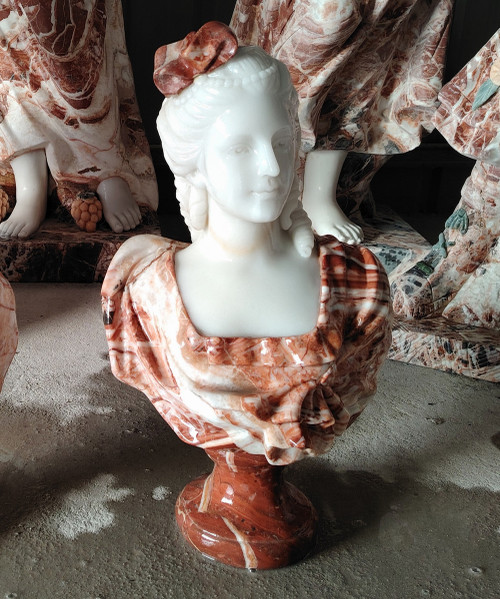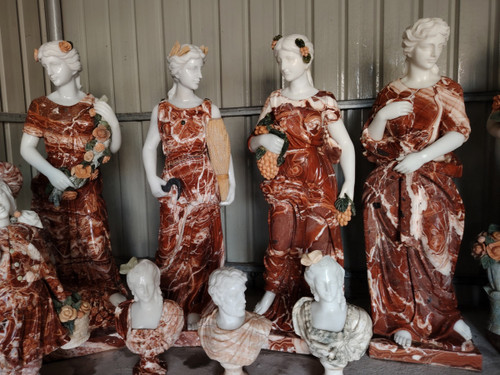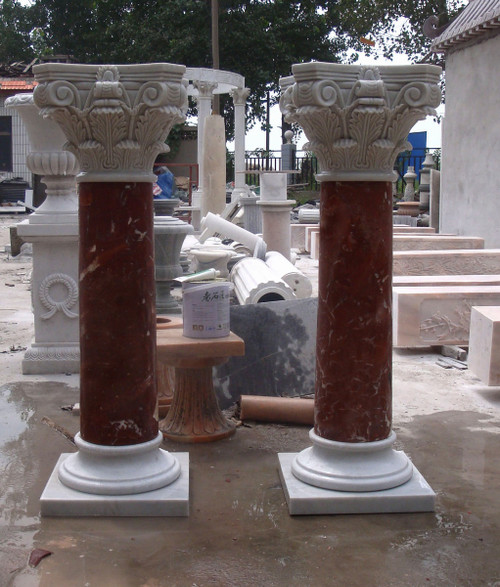-

Bronze and Marble Creations
Hunan White Marble Bench
MSRP: $3,949.00RETAIL: $1,974.50DEALER DIRECT PRICE: $1,579.60
Bronze and Marble Creations
Hole Stone Marble Bench
MSRP: $3,329.00RETAIL: $1,664.50DEALER DIRECT PRICE: $1,331.60
Bronze and Marble Creations
Four Seasons Statues H63 Inches Stand:H11.8 Inches Ge21561
MSRP: $19,718.00RETAIL: $9,859.00DEALER DIRECT PRICE: $7,887.20
Bronze and Marble Creations
Multi Color Milk Marble Lady Bust H23.6 Inches Ge21560
MSRP: $1,698.00RETAIL: $849.00DEALER DIRECT PRICE: $679.20
Bronze and Marble Creations
Red Marble Pair of Garden Flower Urns on Stand H49.2*D23.6 Inches Ge21543
MSRP: $7,598.00RETAIL: $3,799.00DEALER DIRECT PRICE: $3,039.20
Bronze and Marble Creations
Four Seasons Statues H67 Inches Stand:H11.8 Inches Ge21563
MSRP: $26,758.00RETAIL: $13,379.00DEALER DIRECT PRICE: $10,703.20
Bronze and Marble Creations
Four Seasons Statues H67 Inches Stand:H11.8 Inches Ge21562
MSRP: $26,758.00RETAIL: $13,379.00DEALER DIRECT PRICE: $10,703.20
Bronze and Marble Creations
Multi Color Milk Marble Lady Bust H23.6 Inches Ge21559
MSRP: $1,698.00RETAIL: $849.00DEALER DIRECT PRICE: $679.20
Bronze and Marble Creations
Four Seasons Statues H63 Inches Stand:H11.8 Inches Ge21558
MSRP: $24,658.00RETAIL: $12,329.00DEALER DIRECT PRICE: $9,863.20
Bronze and Marble Creations
Sandstone Self Contained Wall Fountain L74.8*H65.4*W35.4 Inches Ge21557
MSRP: $14,078.00RETAIL: $7,039.00DEALER DIRECT PRICE: $5,631.20
Bronze and Marble Creations
Italian White Marble Saint Christopher Statue H72 Inches Ge21556
MSRP: $21,418.00RETAIL: $10,709.00DEALER DIRECT PRICE: $8,567.20
Bronze and Marble Creations
White Marble Virgin Mary Sculpture H70.9 Inches Stand:H16.5 Inches Ge21555
MSRP: $14,078.00RETAIL: $7,039.00DEALER DIRECT PRICE: $5,631.20
Bronze and Marble Creations
White Marble Virgin Mary Sculpture H70.9 Inches Stand:H16.5 Inches Ge21554
MSRP: $14,078.00RETAIL: $7,039.00DEALER DIRECT PRICE: $5,631.20
Bronze and Marble Creations
White Marble Classic Mantel L79.9*H55*W13.8 Inches OPEN?L48.4*H42 Inches Ge21553
MSRP: $8,878.00RETAIL: $4,439.00DEALER DIRECT PRICE: $3,551.20
Bronze and Marble Creations
White Marble Garden Bench L48*H17.7*W13 Inches Ge21552
MSRP: $2,598.00RETAIL: $1,299.00DEALER DIRECT PRICE: $1,039.20
Bronze and Marble Creations
White Marble Swan Bench L70.9*H50*W23.6 Inches Ge21551
MSRP: $12,958.00RETAIL: $6,479.00DEALER DIRECT PRICE: $5,183.20Bronze and Marble Creations
Pair of Decorative Columns H47.2*D15.7 Inches Ge21550
MSRP: $7,598.00RETAIL: $3,799.00DEALER DIRECT PRICE: $3,039.20
Bronze and Marble Creations
Pair of Decorative Columns H47.2*D15.7 Inches Ge21549
MSRP: $7,598.00RETAIL: $3,799.00DEALER DIRECT PRICE: $3,039.20
Bronze and Marble Creations
White Marble Pair of Garden Flower Urns on Stand H51.2*D27.5 Inches Ge21548
MSRP: $10,558.00RETAIL: $5,279.00DEALER DIRECT PRICE: $4,223.20
Bronze and Marble Creations
Red Marble Pair of Garden Flower Urns on Stand H42.5*D21.6 Inches Ge21547
MSRP: $6,758.00RETAIL: $3,379.00DEALER DIRECT PRICE: $2,703.20
Handcarved Marble Sculptures and Garden Décor
The Story of Marble Sculptures: From Stone to Timeless Estate
There’s something almost magical about marble sculptures. More than decoration, they have the rare ability to transform a house into an estate, a garden into a sanctuary, and a foyer into a place of grandeur. The reason lies not just in the beauty of the stone, but in the story it carries through centuries.
Marble has been admired since antiquity. The ancient Greeks first discovered its potential — carving gods, athletes, and heroes from the luminous white stone they quarried in Paros and Naxos. To them, marble was eternal; it captured light like no other medium, giving their figures a lifelike glow. The Romans continued the tradition, filling villas, forums, and baths with statues and columns that symbolized wealth, culture, and refinement. These works became more than art — they were a statement of legacy.
Over time, Europe embraced marble as the pinnacle of elegance. From Renaissance Italy, where Michelangelo carved the David from a single block of Carrara, to the French palaces of Versailles adorned with marble fountains and busts, the stone came to represent artistry, permanence, and power. To own marble was to align yourself with the traditions of the world’s greatest patrons.
That history explains why marble sculptures still hold such admiration today. They bring with them an air of European sophistication and timelessness. A marble fountain on the lawn recalls the gardens of Florence. A hand-carved figure in an entryway echoes the grandeur of Rome. Even a single piece — a pedestal, a bench, or a medallion — creates an instant sense of permanence, transforming an ordinary space into something extraordinary.
What makes marble so special isn’t just its weight or polish — it’s the way it connects a home to history. Every sculpture tells two stories at once: the inspiration of the artist who shaped it, and the lineage of a material that has been treasured for over 2,000 years. That’s why, even today, marble doesn’t just decorate — it elevates. It turns homes into estates, and spaces into legacies.

